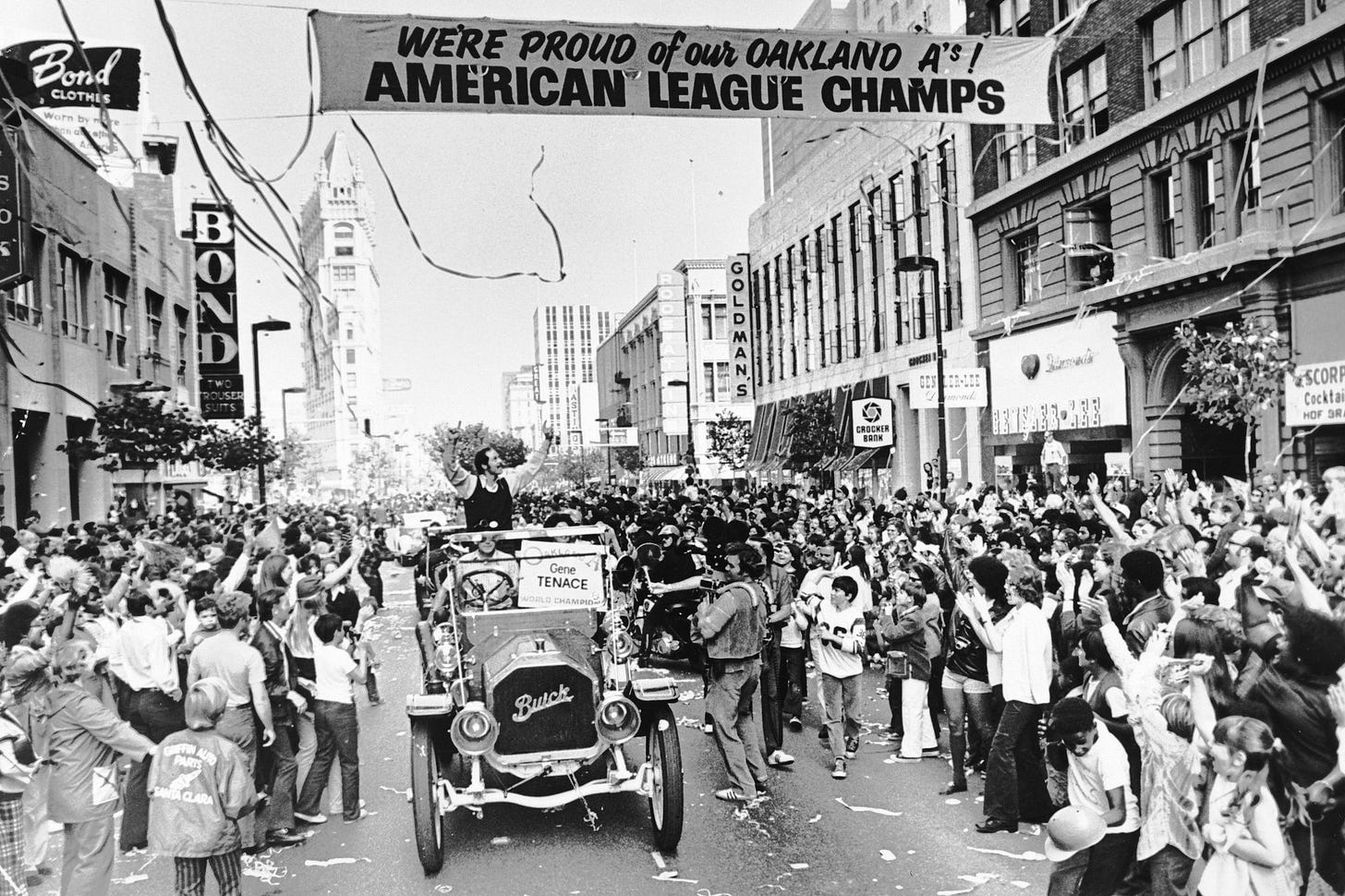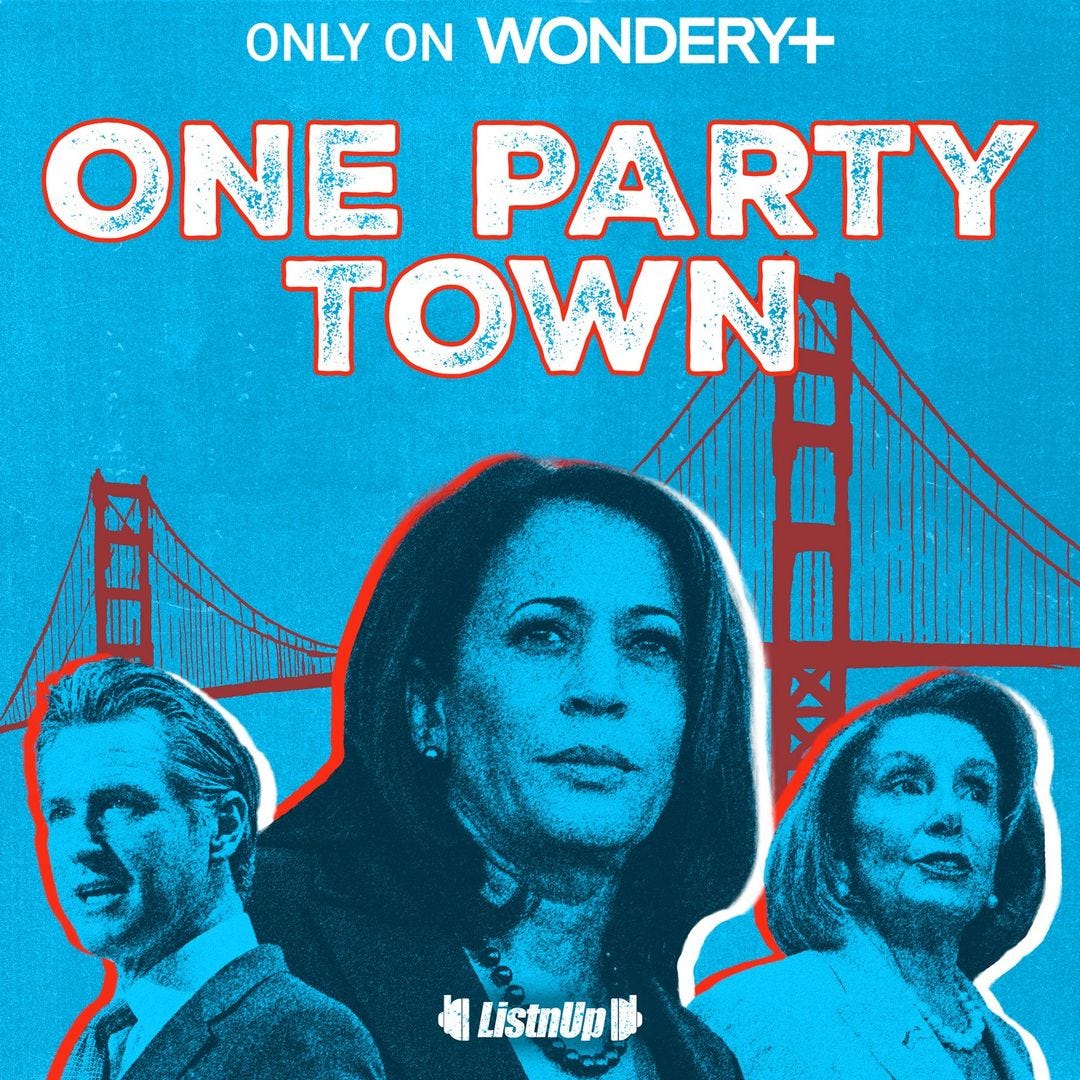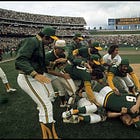This is Throwbacks, a newsletter by me, Michael Weinreb, about sports, history, culture and politics, and everything in-between.
If you like what you read, please click the button below, join the mailing list for FREE and please share, on social media or through e-mail or however you feel comfortable sharing.
And if you’ve been reading for a while, please consider a paid subscription to help keep this thing going—you’ll also get full access to the archive of over 200 articles.
I.
The first Gap store, founded by Don Fisher and his wife Doris, opened on Ocean Avenue in San Francisco in 1969, when the city stood at the zenith of a cultural movement. The Gap sold Levi’s jeans, records, tapes, and nothing else. It was an idea as much as it was a retail outlet; it was literally named after the Generation Gap that had led so many people to flock to San Francisco for the Summer of Love two years earlier. The Gap was a youthful store for a city whose youth had redefined its spirit; the Gap aimed to capture the evolutionary nature of the city itself.
By 1972, the Gap had grown to 25 stores. By the 1980s and 1990s, it had become a multinational conglomerate, and soon evolved into a store that epitomized bland normality. Meanwhile, San Francisco matured into an influential political city, driven in large part by millionaires and billionaires who had forged a powerful machine. San Francisco, between politics and tech, would soon become arguably the most influential city in America. But it lost something along the way.
II.
In 1998, a young prosecutor named Kamala Harris moved across the Bay from the Alameda County district attorney’s office in Oakland to work at the DA’s office in San Francisco. That’s the way it had to be. If you wanted to be somebody—if you wanted to exist in proximity to power, especially as an ambitious young woman of color—you left Oakland behind and came to San Francisco.
As one longtime San Francisco political consultant later told me, Kamala Harris was skillful enough to wade through the corruption that had sprouted up in the city over the course of decades and come out the other side smelling clean, like Andy Dufresne in the Shawshank Redemption. And perhaps part of the reason why is because she understood what was on the other side of the Bay Bridge; perhaps, she might say, she made it to where she is because she understood how real people lived.
III.
I’ve spent a lot of time thinking about these ideas and talking about these ideas and writing about these ideas over the past several years. Long before Kamala Harris became a presidential candidate…long before I moved to Oakland…long before Don and Doris Fisher’s execrable son John—a scion of San Francisco’s wealth and power—chose to move the Oakland Athletics out of the city where they belong, I began digging into the notions of entrenched power for a podcast that’s called One Party Town.
(And here comes the inevitable wave of self-promotion, but the showpage and trailer is now up wherever you get your podcasts. The episodes will drop soon, a couple of weeks before the presidential election. If you can, please bookmark it in the meantime.)
But we’ll have plenty of time to talk about this part. For now, I want to focus on Oakland, and the way John Fisher never really understood what lay on the other side of the Bay Bridge.
IV.
Last Tuesday, I took the BART train to Coliseum station for one of the last games in Oakland Athletics history. I had honestly not been there very often. I had tethered my allegiances to the San Francisco Giants years earlier, but I understood how important this franchise was, and what it meant to a city that had long been marginalized by sheer comparison to the wealth and influence of its neighbor across the Bay.
John Fisher never understood the bond between a community like Oakland and a team that gave it mainstream credibility; from the beginning, as the Chronicle’s Scott Ostler wrote, he viewed his ownership of the A’s as “a straight up real-estate gambit.” Since Oakland was never going to carry the cultural cache of a number of neighboring cities, John Fisher never really got what Oakland meant, or why it mattered, or how it stood in opposition to all those billionaires who lived at the top of the hill in Pacific Heights. He tried to move the team to San Jose and failed. He tried to move the team to a town called Fremont—a parking lot with a mayor—and failed. He failed, and failed, and failed again. He was never serious about anything except his own real-estate gambit.
Anyone who tells you the A’s moving out of Oakland is about anything other than John Fisher’s myopia and incompetence is entirely misinformed. This is his fault alone, and it will always be his fault alone, because he thought he stood above Oakland itself. He’s just another Art Modell now. His fortune was built on a revolutionary idea that had long ago faded away—and it wasn’t even his idea in the first place.
V.
It’s been a strange transition, over the course of those 55 years since Doris and Don Fisher founded the Gap. San Francisco—and the Bay Area—stood for something different back then, and over the course of the 21st century, it’s become a colder and more transactional place. But the hope is that the region will someday find its spirit again, even as John Fisher attempts to wedge himself into Las Vegas, a city that’s entirely devoid of a soul.
As I stood in line at the Coliseum the other night, I heard a guy tell his son that maybe, in some dream scenario, baseball would return to Oakland someday. “I’ll be long gone,” he said. “But maybe you’ll be here to see it.”
This newsletter is a perpetual work in progress. Thoughts? Ideas for future editions? Reply directly to this newsletter, contact me via twitter or at michaeliweinreb at gmail, or leave a comment below. If you enjoyed this newsletter, please join the list and share it with others or consider a paid subscription.





It’s sad enough that Fisher is moving the team out of Oakland. It’s even worse that he doesn’t even have a firm deal for a destination. Three seasons in Sacramento and then hopefully Vegas? Pathetic.
This sums it up really nicely. Possibly the best of a thousand takes out there. You deserve a case of Ballers Hazy IPA for this